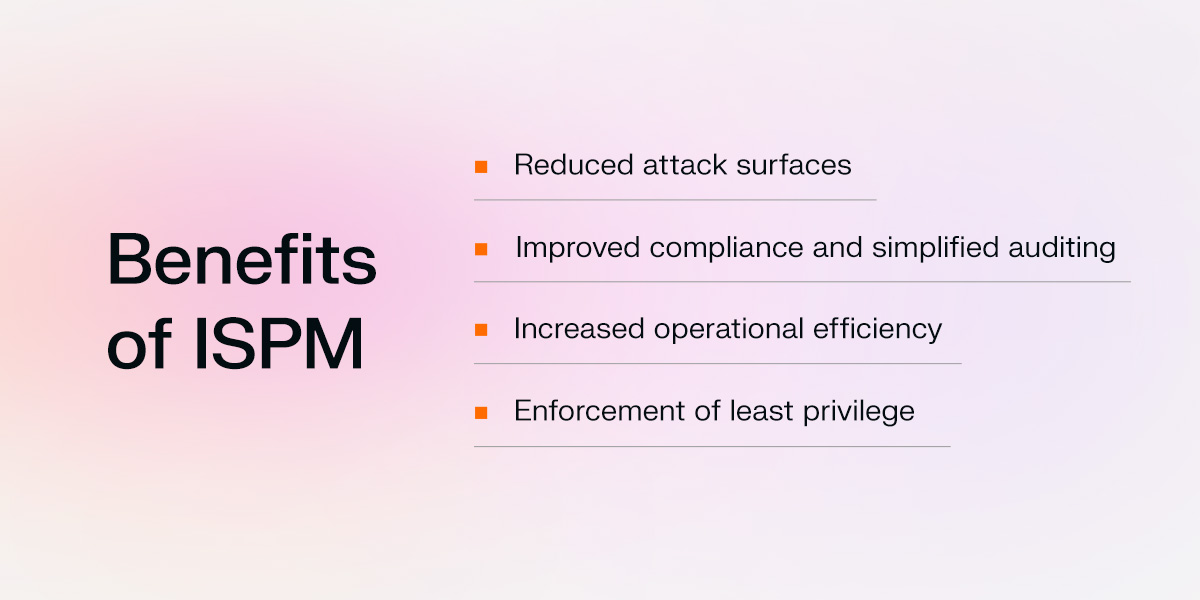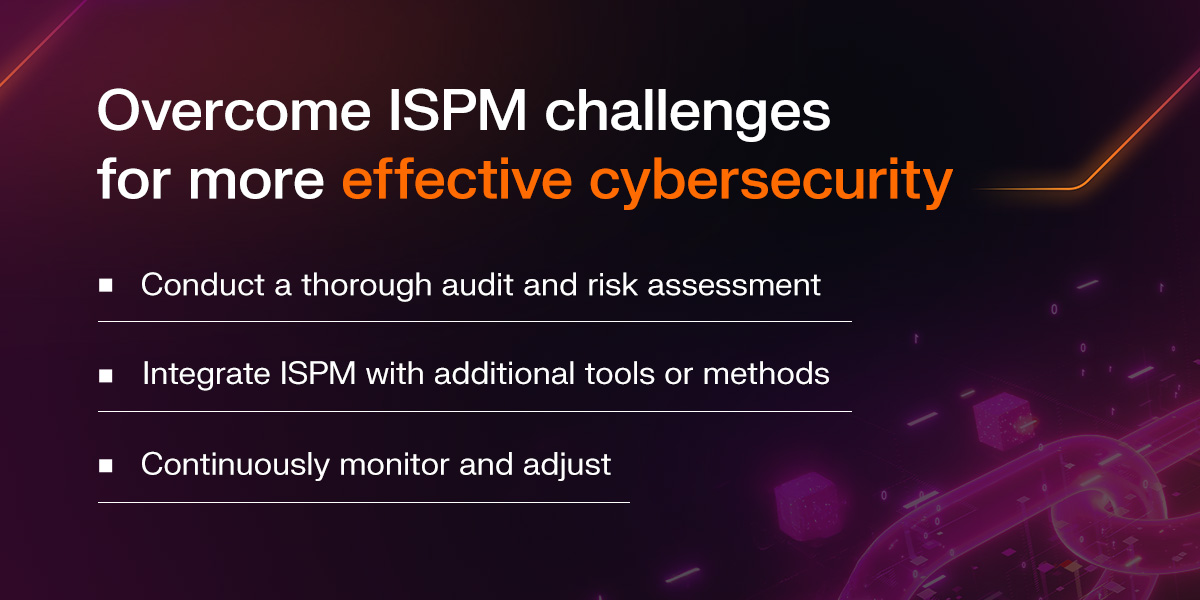Defining Identity Security Posture Management (ISPM)
What is Identity Security Posture Management (ISPM)?
Identities such as service accounts, human users, machine identities, and application programming interfaces (APIs) have increased exponentially in multi-cloud and hybrid environments. This growth presents challenges in managing permissions and entitlements, creating a massive and often invisible attack surface. Identity security posture management (ISPM) is the first step in protecting identities and maintaining better control over them, with a focus on discovering, analyzing, and improving the security of every identity across the ecosystem.
Key components and distinctions of ISPM
Identity security posture management functions as an internal security system, continuously finding vulnerabilities within the ecosystem. The following key pillars enable it to reveal vulnerabilities before they impact identities:
- Comprehensive discovery and greater visibility: ISPM takes a continuous, Application Programming Interface (API)-based inventory of every identity, group, role, account, token, entitlement, and key across an organization's digital landscape.
- Posture analysis and risk identification: Organizations can use an effective ISPM solution to find security vulnerabilities such as exploitable access paths, misconfigurations, toxic permission combinations, and least-privilege gaps.
- Automated remediation and enforcement: ISPM helps close the loop with scalable, safe guardrails through continuous enforcement and one-time remediations.
ISPM vs IAM
Traditional Identity and Access Management's (IAM's) role is to serve as an ecosystem's “front door,” controlling how companies oversee, secure, and maintain digital identities and their access privileges. However, IAM has inherent limitations, and ISPM helps overcome the following challenges to enhance security:
- Entitlement creep: As employees change roles and identities accumulate more access permissions than necessary, ISPM continuously monitors user entitlements. It leverages the Principle of Least Privilege (PoLP), automatically revoking or flagging excessive permissions.
- Dormant accounts: Employees may leave orphaned or dormant accounts behind when they leave or change roles, creating an unmonitored, persistent security risk. ISPM's comprehensive visibility across the identity landscape makes it easier to reveal dormant accounts that traditional IAM systems might miss.
- Improper combinations of low-risk permissions: A group of low-risk permissions can create a permission chain that's easy for attackers to target and exploit. ISPM's analytics and risk assessment capabilities identify misconfigurations and problematic permission combinations to prevent exploitation.
- Lack of comprehensive visibility: Organizations often lack a single, unified view of all human and nonhuman identities, their activities, and their entitlements across the ecosystem.
Using ISPM as an additional security layer on top of IAM enhances an organization's protection. ISPM continuously monitors identities and ensures that they consistently apply IAM policies. The ISPM also identifies potential vulnerabilities within the IAM and helps ensure access rights align with regulatory requirements and business needs.
ISPM vs CIEM and CSPM
ISPM acts as an umbrella over an ecosystem, while Cloud Infrastructure Entitlement Management (CIEM) and Cloud Security Posture Management (CSPM) serve as subsets underneath this umbrella. A CIEM organizes data into one centralized view to maximize visibility and efficiency, and a CSPM identifies and remediates risks in cloud environments. ISPM is the broader framework in which CSPM and CIEM work together.
Benefits of ISPM

ISPM implementation offers the following advantages:
Reduced attack surfaces
ISPMs significantly reduce attack surfaces by limiting the amount of time threat actors have to exploit vulnerabilities. It continuously monitors and assesses identity-related risks, allowing organizations to prioritize the most critical identity-related vulnerabilities and decrease exposure. This capability helps prevent unauthorized access attempts and breaches.
Improved compliance and simplified auditing
ISPM makes it easier for organizations to meet regulatory requirements such as Payment Card Industry Data Security Standards (PCI-DSS), the General Data Protection Regulation (GDPR), the Health Insurance Portability and Accountability Act (HIPAA), and standards related to identity or access management. Its comprehensive visibility gives organizations more control over access rights, which helps simplify auditing and reduce compliance-related risks.
Increased operational efficiency
Implementing ISPM helps streamline identity life cycle management work, such as offboarding and onboarding processes. This solution centralizes governance, ensuring consistent policy enforcement while decreasing administrative overhead and manual tasks. Organizations can use ISPM to reduce costs by optimizing resource allocation, avoiding compliance-related penalties, eliminating redundant tools, and minimizing the financial impacts of breaches.
Enforcement of least privilege
An ISPM's continuous monitoring, advanced analytics, and automation enable it to find vulnerable misconfigurations or access points that manual processes may overlook. It enforces least privilege access and adaptive authentication to target common attack vectors linked to lateral movement and compromised credentials.
Challenges of ISPM
Understanding the following challenges of ISPM is important for ensuring proper implementation:
- Complexity of the modern IT environment: A complex IT environment makes it more challenging to maintain a consistent security posture. Data silos, fragmented architectures, and a high velocity of change can create unknown risks. ISPM requires unified visibility to enforce consistent policies and track user activities.
- Misconfiguration risks: Misconfigurations such as poor identity life cycle management, a lack of multi-factor authentication (MFA), or excessive privileges allow threat actors to move laterally across an ecosystem. Organizations must ensure proper implementation and end-to-end credential management for an effective ISPM.
- Legacy systems: Legacy systems typically operate on outdated software and in isolated silos, which can lead to unpatched vulnerabilities or integration challenges. ISPMs are most effective when organizations ensure compatibility with their systems.
- Resource limitations: Upgrading old systems and training staff to manage complex identity systems may require additional resources.
- Evolving threat landscapes and attack techniques: Threat landscapes and attack techniques continuously evolve. For optimal security, ISPM must keep pace. Advanced AI technology is vital for effective ISPM deployment because it detects anomalies and stops threats before they cause damage.
How to overcome ISPM challenges for more effective cybersecurity

Implement the following solutions to help overcome the challenges of ISPM:
Conduct a thorough audit and risk assessment
A thorough audit and risk assessment helps identify and inventory existing identity security vulnerabilities such as:
- Dormant accounts
- Excessive privileges
- Weak authentication
An assessment also helps you discover shadow IT and remove any devices or applications causing compliance gaps.
Integrate ISPM with additional tools or methods
Integrating ISPM with other tools or methods creates a holistic approach that covers all areas of your digital ecosystem. You can combine ISPM with effective tools and strategies such as zero trust, real-time threat detection, Security Information and Event Management (SIEM), and IAM.
Continuously monitor and adjust
Establish key performance indicators (KPIs) and clear metrics to track your ISPM strategy's effectiveness and areas for improvement. It's also important to choose an AI-powered ISPM program that can track threats in real time. Doing so enables you to adapt to evolving cybersecurity threats and continuously adjust your security approach where necessary.
Explore additional Darktrace resources
Learn more about ISPM and how it can strengthen your overall cybersecurity posture. Explore our blog or download our solution briefs on Darktrace / IDENTITY and Darktrace / NETWORK for more insights.

























